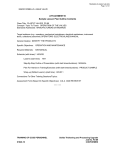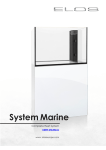Download View our Radiant Kerosene Heater Reference Manual - Rent-E-Quip
Transcript
Radiant Kerosene Heater Reference Manual Our technical service manual is not a substitute for the actual owner’s manual, but a compilation of data that can be used to maintain and repair most heaters. We have tried to simplify the names of the most popular replacement parts and have several schematic drawings to assist you. The parts identified in the schematics will match the part names listed in the cross references. Kerosene Heaters A to Z A kerosene heater is a simple device whose purpose is to burn fuel and to provide heat. A wick is used to lift kerosene from a fuel tank into a burner assembly. The burner is designed to mix air from the room with kerosene vapor. This mixture is then burned, creating heat. The wick is raised or lowered by a large knob in front of the wick holder assembly. A safety device called a tip over switch is incorporated as a part of the wick holder assembly. For added convenience, the heater is equipped with an automatic ignition system that is used to light the heater. It also has a fuel level gauge. For safety, the heater comes with a protective wire grille installed. There are two types of kerosene heater, convection style (round) and radiant style (square). The basic principles are similar but not identical. Once a heater has been correctly designed and manufactured to efficiently mix kerosene vapor with air for burning, the most important element becomes the kerosene fuel itself. The most common complaint with kerosene heaters is the odor, the second most common is smoking. Poor kerosene and poor wick maintenance cause odor. The cause of smoking is simple and easy to solve. Smoke is nothing more than excess fuel which has not been mixed with enough oxygen to burn completely. The severe form of smoke results in carbon buildup known as soot. To solve a smoking situation, the amount of fuel being delivered to the burn chamber must be reduced. This is done by lowering the wick height and reducing the height of the flame observed at the top of the burner. Also, make sure that the chimney is seated properly on the burner. The above applies to a new heater or a heater in good working condition. The use of bad fuel or a wick that has not been properly maintained can also result in smoking. In most cases, it will be necessary to replace the wick. A wick must be thoroughly soaked in kerosene (2 hours soaking time is best) before being used for the first time. An explanation of the functions of the wick and burner assembly is described in "FUNCTIONS OF MAJOR PARTS". Kerosene Heaters and Odors Years ago, kerosene heaters provided warmth on the farms and in the homes and shops of America. Older people recall them as smelly, smoky devices that we were happy to be rid of when lowcost natural gas, electricity, and heating became plentiful. Today, these formerly cheap sources of energy have become far too expensive to use carelessly. At the same time, the kerosene heater has developed into the most efficient source of heat available to the American people. In fact, the kerosene heater is so efficient that it can be burned indoors with venting. Even though the new style kerosene heaters are wonderfully efficient, there are still times when you must expect a kerosene odor. They are as follows: Whenever you fill your heater, where will be an opportunity for the fuel to vaporize and create an odor in the air. This is why it is a good idea to fill your heater in a garage or out of doors. When a kerosene heater is first ignited, it takes a few minutes for the fuel to mix with the air in the perfect ration for complete combustion. For that space of time, the fuel air mixture is RICH. This results in a small amount of unburned kerosene. Once the heater is burning normally, no additional odor will be created. An improperly adjusted wick can cause smoke and odor. This is simply corrected by moving the wick slightly. A wick with carbon build up will also cause odor. This wick should be replaced. The final time when you must expect to smell kerosene is when you turn off your heater. You must realize that the wick holder is quite warm. When you lower the wick it continues to draw kerosene, causing a vaporization of the fuel which you detect as odor. All of the things mentioned above are common and normal and are to be expected when you use your kerosene heater. If you find yourself particularly sensitive to the slight odor that is produced under these conditions, you may wish to place an freshly extinguished heater on an unused porch to avoid the natural smell of the kerosene fumes. A final important note, is that there are a number of grades of kerosene on the market. The most highly refined grade is called low sulfur, grade K1 and contains only a small amount of sulfur that is a very smelly chemical compound, the one responsible for the bad smell of rotten eggs. Any effort spent in obtaining an uncontaminated, low sulfur, grade K1 kerosene will be rewarded in the reduction of the undesirable odor. Imperfect Combustion It's Causes and Results 1. Lack of Air. When there is insufficient air (too much fuel for the available air supply), all the available fuel cannot be burned. Soot forms and the excess unburned fuel appear as smoke and produces odor. NOTE: The appearance of smoke indicates the existence of this condition. 2. Excessive Air If the proportion of available air to the available fuel is excessive (too much air, not enough fuel). The mixture of kerosene vapor and air reduces the temperature of the burning gases. This results in a deposit of tar on the wick and wick adjuster and kerosene odors are released into the air. 3. Impure Kerosene The use of kerosene contaminated with minute amounts of water, adulterated with other oils, or kerosene that has been left in direct sunlight for a prolonged period of time will result in clogging of the wick with tar or water, the formation of soot from incomplete combustion, and the release of odors. RADIANT TYPE WITH CARTRIDGE TANK Fuel Supply System Kerosene is supplied to the top of the wick using the capillary tube effect of the wick from the fixed kerosene surface (Torricelli's law) made up of the cartridge tank and sump tank. Air supply system, ignition method, exhaust method and safety mechanism are all the same as for the integral type. CONVECTION TYPE Fuel Supply System The kerosene is supplied to the top of the wick using the capillary tube effect of the wick from the fixed kerosene surface which is formed by the primary and secondary tanks. Air Supply System The air is supplied through the air tube to inside the circle of flames, while the air outside the circle of flames is supplied by the outer tube and the middle tube. Ignition Method The wick is ignited by the ignition coil. Exhaust Method The exhaust gases are expelled inside the room using the draft of the burner assembly. Safety Mechanism Automatic extinguishing device. Function of Major Parts Wick STRUCTURE OF WICK Structure and functions A kerosene heater is an appliance in which kerosene is gasified by surface evaporation and burned. The amount of kerosene evaporated and heat generated can be increased in direct proportion to the area of the contact surface between the kerosene and air. The wick used in a kerosene heater consists of many bundles of fine fibers and, in accordance with the principle behind it, it is designed to provide a large evaporation area. A wick consists of bundles of thin fibers and countless capillary tubes. The kerosene is drawn up from the tank into the combustion area by these capillary tubes. As a result, if the kerosene becomes viscous or dirt and dust find their way inside the heater, the capillary tubes will become clogged. This will cause a deterioration in the drawing of the kerosene and combustion will no longer be possible. As shown in the figure on the right, a wick is formed by a fiberglass wick at the top and a cotton wick at the bottom. Fiberglass Wick The fiberglass wick is make of special glass fibers (60%) and carbon fibers (30%) with consideration given to its strength and workability. This wick causes the kerosene to vaporize from the surface of the very thin glass fibers and sends the kerosene vapor to the combustion section. Combustion results when ignition takes the form of a direct flame, and with normal combustion, the flame is fed by the kerosene vapor without direct contact with the wick. Cotton part of wick The cotton wick is made of cotton fibers with excellent moisture absorption properties, and it serves to lift the fiberglass wick using the capillary tube effect. In order that the wick height may be adjusted smoothly, a special weaving method is used for the bottom of the wick where threads running crosswise are not employed. This increases the elasticity of the wick. Handling cautions and reasons WICK CAPILLARY TUBES (MODEL) AND STATE OF KEROSENE For initial ignitions, about 2 hours should be allowed to elapse after the kerosene has been supplied before actual ignition. The wick serves to lift the kerosene to the combustion section using the capillary tube effect but, depending on the size of the capillary tubes, there may be some difference in the time taken for the kerosene to reach the top of the wick. If ignition is attempted before the kerosene has soaked into the wick sufficiently, a large number of air holes are formed in the middle of the wick and this downgrades the kerosene suction effect. When kerosene is not drawn up properly, the flames come into contact with the wick, the temperature of the wick rises to an abnormally high level, the vaporization ability of the kerosene drops. Kerosene which has been vaporized now comes into contact with the wick frame or air tube, it cools off and results in the formation of tar on the wick. Consequently, the kerosene drawing ability gradually deteriorates so that combustion is no longer possible and wick height adjustment can no longer be made. Kerosene of different quality or of a quality liable to undergo some form of change, or gasoline should not be used. If kerosene of a different quality or of a quality liable to undergo changes or oils with a higher viscosity than of kerosene are mixed with the kerosene, the drawing ability deteriorates, the capillary tubes block up and, as in the previous sections combustion cannot be produced and the wick height adjustment can no longer be made. If kerosene with gasoline, benzene or an oil with a low level of viscosity mixed with it is used, the gasoline, benzene or oil will be drawn up before the kerosene to create the danger of uneven flames or explosion. In addition, air holes will be formed in the middle of the wick resulting in lessened drawing ability, defective combustion and the inability to adjust the height of the wick. Kerosene containing any water must not be used. If kerosene containing water is used and the water is drawn up, the capillary tubes will become blocked up with water, thereby making it impossible for the kerosene to be drawn up. This results in defective combustion and the inability to adjust the height of the wick. Insufficient combustion must not be allowed. If the wick height is reduced for use, the flame comes into contact with the wick. This results in the formation of tar on the wick, no combustion and the inability to adjust the height of the wick. CROSS SECTION OF WICK'S VAPORIZATION POSITION WickRaising Mechanism Convection Type WICK RAISING MECHANISM CONVECTION TYPE When the wick control knob is rotated clockwise, the pin at the other end of the wick control shaft rotates. The wick frame rises by rotating the rack mounted along the outer circumference of the wick frame. This results in the wick, which is mounted through the wick frame, being lifted up at the same time. When the wick control shaft is rotated counterclockwise, the energy stored, by the counterclockwise rotation, in the torsion spring which is attached to the shaft at one end and to the wick control shaft at the other is retained by the latch which is coupled with the ratchet and shut off device. WICK RAISING MECHANISM Automatic Extinguishing Mechanism Drop Type AUTOMATIC EXTINGUISHING MECHANISM When the pendulum starts swinging due to an earthquake or shock, the wick control shaft ratchet and wick control knob rotate counterclockwise by the force of the torsion spring after the latch has been released from the ratchet. This results in a quick drop of the wick and puts out the flame. Burner Unit The burner unit serves to mix the kerosene vapor, after it has been vaporized from the wick, with the oxygen in the air for combustion. In a kerosene heater, it functions to supply air for combustion using the draft effect of the hot air current. The burner unit can be divided into the following two types by their structure: 1. Radiant type (glass outer cylinder) 2. Convection type (metal outer cylinder) CONVECTION TYPE BURNER UNIT RADIANT TYPE CONVECTION TYPE The burner unit should be set properly and securely on the wick frame and air tube. If the burner unit is not set properly, the air supplied by the draft will become unstable. An irregular eddy motion will be caused in the kerosene vapor and combustion gases and the flame formations will be outside the combustion area. This will result in the creation of carbon monoxide or odors and the generation of soot and black smoke. Any soot forming on the inner and middle tubes of the burner tube must be promptly cleaned. The small holes in the inner and middle tubes have a pitch which allows the air and the kerosene vapor to be mixed in the most effective way. If soot forms, for instance, on just one of these holes, the whole balance is upset and imperfect combustion results. A burner unit which has been deformed or misshaped must not be used. If the inner tube, middle tube, outer tube (including glass), flame extending plate, radiator coil is deformed, turbulence arises in the supply of air, causing imperfect combustion. In particular, it should be noted that the radiant type heaters must not be operated with cracked or broken glass. Replacing Igniter IGNITER When the ignition knob is pushed, the lever rises at the same time as the burner unit is raised. The igniter coil rotates, and when it approaches the wick and ignition results. When the end of the igniter coil does not touch the wick, no ignition results. If the wick is not correct, adjust if for immediate ignition. Should you experience difficulty with the automatic lighting mechanism, first, replace the batteries. If the proper glow of the igniter is not restored, the igniter coil may be burned out and require replacement. This should be done on a completely cool heater. Allow auto shut off to snap shut by jarring heater body. Remove the batteries to prevent possible burns. Remove top plate by spreading wire handle which holds it in place. Remove outer cover by removing 4 screws. Lift burner unit out of heater. Push the ignition knob to expose the igniter coil. Hold the socket in your free hand and remove the igniter by pushing in and twisting counterclockwise to release it from its socket. Insert the replacement igniter, turn clockwise to lock into position. Reinstall batteries outer cover with 4 screws, burner, top plate and carrying handle. REPLACING IGNITER When Impure (Defective) Kerosene is Used When impure kerosene is burnt, tar forms around the top of the wick and the wick hardens. If this state advances, it results in resistance to wick control and finally in the inability to control the height of the wick. TAR ON WICK Test Igniting Kerosene with Water Mixed In If ignition is attempted when kerosene contains water, the water will be absorbed after all the kerosene has been absorbed. The glue which adheres the tape to the wick is dissolved in the water and the tape either peels off or becomes wrinkled. When this occurs, the wick can no longer be controlled. Even if kerosene is resupplied, a portion of the wick which permits combustion of the absorbed kerosene is reduced drastically and the kerosene heater cannot be used. WICK AFTER WATER HAS BEEN ABSORBED AND ATTEMPTED TO RAISE Wick Maintenance Cleaning the Wick The wick is specially developed fiberglass. It will not burn without fuel like conventional cotton wicks. But it needs proper attention to get long life. 1. Wick should be burned off when: · · · · · a) Second or third tankful of kerosene has been used. b) The wick control knob becomes hard to turn. c) The radiator metal does not get red hot although the wick is turned up all the way. d) The wick is hard to ignite. e) Unpleasant odor is produced during use. 2. How to burn off the wick: WICK MAINTENANCE A wick in good condition will feel soft, while one that is carbonized will feel like a bristle brush and, in late stages, the top might even be coated with hard black carbon. Use of the purest kerosene available will slow this process. This is called K1 grade (low sulfur). To restore a wick to original softness, remove all the fuel from the tank or wait until the tank is empty, or remove the fuel cartridge on cartridge type heaters. The remaining fuel in the reservoir will be used in the "burn off" process. Turn the wick to the highest position. Light it with a match if you cannot light automatically. Be sure the chimney is properly centered. Let burn until the fire is out completely. If you feel that some carbon still remains, merely raise the chimney and relight with a match. Let it burn again until out. This "burn off" should be done in a garage, a porch, or a place where odors will not be offensive. Burning a wick dry does no harm to the wick itself. Allow the wick to cool, then remove any remaining ash with an old toothbrush. You may vacuum away any residue or soot remaining in the burner area. 3. Use of other than pure, clean, waterfree kerosene Grade K1 low sulfur will damage the wick. Wick Hardening When impure kerosene is burned, tar forms around the top of the wick and the wick hardens. If this condition continues, it causes the wick to stick in the draft tube and it becomes impossible to raise or lower the wick.





















